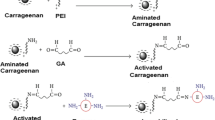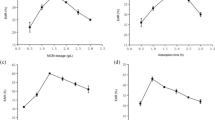Abstract
A novel affinity covalent immobilization technique of glucoamylase enzyme onto ρ-benzoquinone-activated alginate beads was presented and compared with traditional entrapment one. Factors affecting the immobilization process such as enzyme concentration, alginate concentration, calcium chloride concentration, cross-linking time, and temperature were studied. No shift in the optimum temperature and pH of immobilized enzymes was observed. In addition, K m values of free and entrapped glucoamylase were found to be almost identical, while the covalently immobilized enzyme shows the lowest affinity for substrate. In accordance, V m value of covalently immobilized enzyme was found lowest among free and immobilized counter parts. On the other hand, the retained activity of covalently immobilized glucoamylase has been improved and was found higher than that of entrapped one. Finally, the industrial applicability of covalently immobilized glucoamylase has been investigated through monitoring both shelf and operational stability characters. The covalently immobilized enzyme kept its activity over 36 days of shelf storage and after 30 repeated use runs. Drying the catalytic beads greatly reduced its activity in the beginning but recovered its lost part during use. In general, the newly developed affinity covalent immobilization technique of glucoamylase onto ρ-benzoquinone-activated alginate carrier is simple yet effective and could be used for the immobilization of some other enzymes especially amylases.












Similar content being viewed by others
References
Gerhartz, W. (1990). General production methods. In W. Gerhartz (Ed.) Enzymes in industry (p. 67). New York: VCH.
Shankar, V., Nehete, P. N., & Kothari, R. M. (1993). Indian Journal of Biochemistry & Biophysics, 30, 62–70.
Ida, J., Matsuyama, T., & Yamamoto, H. (2000). Biochemical Engineering Journal, 5, 179–182.
J-T, Oh, & Kim, J.-H. (2000). Enzyme and Microbial Technology, 27, 356–361.
Bahar, T., & Celebi, S. S. (2000). Enzyme and Microbial Technology, 26, 28–33.
Bahar, T., & Celebi, S. S. (1998). Enzyme and Microbial Technology, 23, 301–304.
Tanaka, H., Kurosawa, H., Kokufuta, E., & Veliky, I. A. (1984). Biotechnology and Bioengineering, 26, 1393–1399.
Tanriseven, A., Bozkurt Uluda, Y., & Dogan, S. (2002). Enzyme and Microbial Technology, 30, 406–409.
Mohy Eldin, M. S., Hassan, E. A., & Elaassar, M. R. (2005). Deutsch lebensmittel Rundschau, 101, 255–259.
Mohy Eldin, M. S. (2005). Deutsch lebensmittel Rundschau, 101, 309–314.
Lee, P. M., Lee, K. H., & Siaw, Y. S. (1993). Journal of Chemical Technology and Biotechnology, 58, 65–70.
Li, T., Wang, N., Li, S., Zhao, Q., & Guo, M. (2007). Biotechnological Letters, 29, 1410–1416.
Teotia, S., Lata, R., Khare, S. K., & Gupta, M. N. (2001). Journal of Molecular Recognition, 14, 295–299.
Silva, R. N., Asquieri, E. R., & Fernandes, K. F. (2005). Process Biochemistry, 40, 1155–1159.
Rebros, M., Resenberg, M., Milchova, Z., Kristofikova, L., & Paulch, M. (2006). Enzyme and Microbial Technology, 39, 800–804.
Park, D., Haam, S., Jang, K., Ahn, I., & Kim, W. (2005). Process Biochemistry, 40, 53–61.
Tanriseven, A., & Olcer, Z. (2008). Biotechnology and Bioengineering Journal, 39, 430–434.
Serour, E., & Antranikian, G. (2002). Antonie van Leeuwenhoek, 81, 73–83.
Arica, M. Y., Alaeddinoglu, N. G., & Hasirci Enzyme, V. (1998). Microbial Technology, 22, 152–157.
Sanjay, G., & Sugunan, S. (2005). Catalysts Community, 6, 525–530.
Silva, R. N., Asquieri, E. R., & Fernández, K. F. (2005). Proceedings of Biochemistry, 40, 1155–1159.
Bai, Y., Li, Y., & Wang, M. (2006). Enzyme and Microbial Technology, 39, 540–547.
Czichocki, G., Dautzenberg, H., Capan, E., & Vorlop, K. (2001). Biotechnological Letters, 23, 1303–1307.
Dudra, A. H., Bryjak, J., & Trochimczuk, A. W. (2007). Enzyme and Microbial Technology, 41, 197–204.
Bryjak, J. (2003). Biochemical Engineering Journal, 16, 347–355.
Uhlich, T., Ulbricht, M., & Tomaschewski, G. (1996). Enzyme and Microbial Technology, 19, 124–131.
Arica, M. Y., Handan, Y., Patir, S., & Denizli, A. (2000). Journal of Molecular Catalysis. B, Enzymatic, 11, 127–138.
D’Souza, S. F., & Kubal, B. S. (2002). Journal of Biochemical and Biophysical Methods, 51, 151–159.
Milosavic, N., Prodanvic, R., Jovanovic, S., & Vujcic, Z. (2007). Enzyme and Microbial Technology, 40, 1422–1426.
Author information
Authors and Affiliations
Corresponding author
Rights and permissions
About this article
Cite this article
Eldin, M.S.M., Seuror, E.I., Nasr, M.A. et al. Affinity Covalent Immobilization of Glucoamylase onto ρ-Benzoquinone-Activated Alginate Beads: II. Enzyme Immobilization and Characterization. Appl Biochem Biotechnol 164, 45–57 (2011). https://doi.org/10.1007/s12010-010-9113-y
Received:
Accepted:
Published:
Issue Date:
DOI: https://doi.org/10.1007/s12010-010-9113-y




